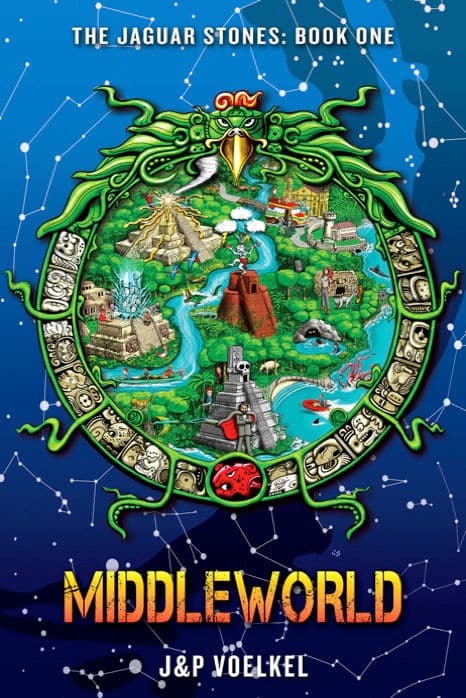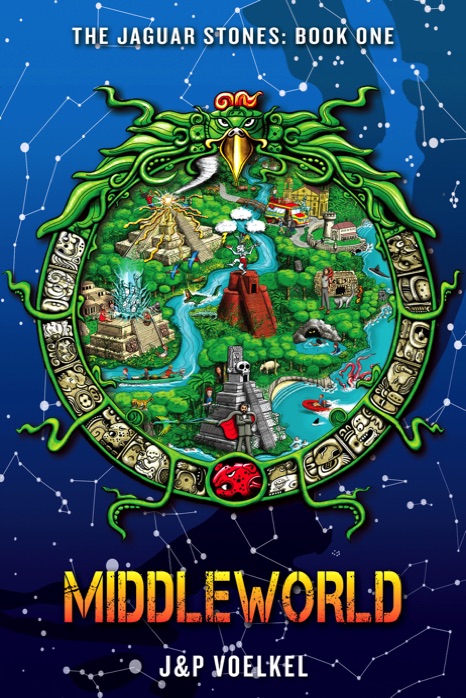BooksforTopics Reading for Pleasure Recommendations
We often get asked about recommendations for books that support the Ancient Maya topic (see our Ancient Maya booklist here) and one of the most popular among our recommendations in Upper KS2 is Middleworld by J&P Voelkel (available here). Middleworld is an action-packed adventure novel filled with suspense and excitement, with a good level of depth for upper KS2. This book, which is the first in a popular series, tells the story of fourteen-year-old Max, who finds himself on a quest to rescue his archaeologist parents from the Mayan underworld and to save the world from the Lords of Death.
To tie in with the UK schools’ tour this week, we’ve been asking authors J&P Voelkel all about the research behind the stories and how to use the books in the classroom alongside a Mayan topic.

Author Q&A
with J&P Voelkel, authors of Middleworld
For those unfamiliar with the series, can you explain what to expect from Middleworld?
It’s a fast-paced and funny adventure set in the jungles of the Maya, but it’s also a tale of teenage angst and finding your place in the world. The main characters are Max Murphy, a 14-year old city kid from Boston, and Lola, a Maya girl of about the same age. Against a background of haunted temples, raging underground rivers, and the ever-present frisson of human sacrifice, Max and Lola must work together to solve a terrible mystery – and, quite possibly, save the world from the ancient Maya Lords of Death.
What was the inspiration behind the story?
The inspiration came from three places. First of all, Jon grew up in Central and South America, and his family would often take trips deep into the rainforest. (Once they even visited some pyramids in Mexico, so those memories must have played a part.) Secondly, there was a long-running bedtime story he used to tell our children, where they would add a new chapter every night. The kids would choose three things they wanted in that night’s story, and one night our son chose a pyramid, a girl who spoke to monkeys, and night-vision goggles – you’ll find that exact scenario in Middleworld! Thirdly, we were inspired by our research: all the modern Maya children we met, the archaeologists who explained the ancient writing to us, the beautiful ruined cities we explored, and all the books we read – especially the Popul Vuh, the Maya myth of the Hero Twins who battle the Lords of Death.
Many schools are choosing this book to complement their Ancient Maya topic in KS2. Which aspects of the books are based on real places and events from Mayan history?
The books are set in the present day and most of the action takes place in San Xavier, a fictional Central American country based on Belize. All the pyramids, temples and observatories in the story are based on actual Maya ruins. Many of the characters are modern Maya people and inspired by real people we’ve met on our travels.
While the Jaguar Stones themselves are fictitious, they were partly inspired by a jade carving that was found in a tomb at Altun Ha in Belize. This volleyball sized head of the sun god is the largest jade object ever discovered in the Maya area. The fictional powers of the Jaguar Stones are based on the true achievements of the ancient Maya: astronomy, military prowess, creativity, agriculture, politics and trade. Everything else in the books – the gods, the myths, the calendar, the astronomy, the language, the architecture – is authentic. Even the illustrations of Maya glyphs say exactly what they are supposed to say.
There’s so much detail in the stories – how did you research the mythological and cultural aspects of the Mayan setting? And what’s the coolest fact you found out in the process?
The Maya are a fascinating people and we’ve enjoyed learning about them. First of all, we read every book on the ancient Maya that we could lay our hands on. Then Jon did a course at Harvard on reading and writing Maya glyphs. But our most important research has been the many trips we’ve made down to Belize, Guatemala and Mexico, where we’ve talked to contemporary Maya people, canoed underground rivers, tracked howler monkeys, explored cave systems and visited over eighty ancient Maya sites. We also attend conferences where the leading Maya archaeologists present their latest discoveries.
Some of the coolest things we’ve discovered:
– only 2% of ancient Maya structures have so far been excavated
– with the new remote sensing LIDAR systems, archaeologists are making huge new discoveries every year
– over 80% of Maya glyphs can now be read, and the personal stories of ancient people are being brought to life.
There’s a real sense of adventure in these stories. What’s the most exciting adventure you’ve ever had?
Our trips have had some very exciting moments – particularly ones we’ve shared with our children, like trekking through the forest to some ancient site, or being woken in the middle of the night by a group of noisy howler monkeys on the roof of our shack, or almost getting marooned at a remote site when a sudden rainstorm cut off the road, or watching a swirling vortex of three million bats emerge from a small cave at dusk – and the time we forgot to pack food and had to feed the kids termites for breakfast. But we both agree that the scariest moment of all was being interviewed by Al Roker on live TV for the Today Show.
What advice would you give to teachers wishing to bring the Ancient Maya topic alive for their pupils?
We’ve been working with schools in the States for a number of years and we know how hard it is to find reliable sources. There’s a lot of misinformation out there about the ancient Maya, and it’s tricky to separate fact from fiction. That’s why we’ve created an extensive collection of free educational resources, lesson plans and videos on our website www.jaguarstones.co.uk. They’re full of programmes and activities that schools have used to help bring the ancient and modern Maya alive. Over the coming months, we’ll also be adding new material designed specifically for UK teachers – including lesson plans, downloadable posters and bookmarks, newsworthy articles, and an interactive web module where students can create their own Maya name glyphs.
We’re excited to hear about your UK tour this year. Tell us more about where and how UK readers can catch up with the tour.
We’ve been Skyping with UK schools for a while, but this is our first UK book tour. We’ll be visiting ten schools in Yorkshire, Cumbria, Lincolnshire, Essex, Oxfordshire, Hampshire and Wiltshire. Our high energy, multi-media presentation is full of mayhem, surprises and audience participation (to reflect the spirit of our books) and takes the students from a walk in the rainforest of Middleworld to the crazy rock’n’roll concert in the End of The World Club. Along the way, we’ll summarize the essential facts about the amazing Maya, rainforest survival, archaeology, and the importance of research. Students will also learn how to call a howler monkey – which is, in our opinion, a very underrated and useful skill.
You can order Middleworld online or from your local bookshop or library.
—————–
***Book Giveaway!***
Thanks to the authors of Middleworld, we have three copies of Middleworld: Jaguar Stones to give away to our followers.
There are two ways to enter:
1. Twitter entry – To enter, follow @booksfortopics and RT the giveaway tweet.
2. Instagram entry – Follow @booksfortopics on Instagram & TAG in the giveaway post’s comments a friend who may also like to win this book for their home or school library.
We will give away 2 copies for Twitter and 1 for Instagram. You can enter twice! Giveaway closes 11.59pm 15th March (UK) – terms and conditions here.
——————————
You can order Middleworld online or from your local bookshop or library.
Many thanks to the authors for answering our questions and providing the giveaway prizes.
Where next?
> Visit our Reading for Pleasure Hub
> Browse our Topic Booklists
> View our printable year group booklists.
> See our Books of the Month.









